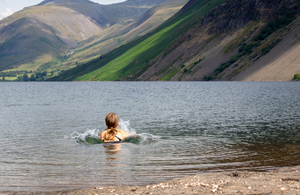
England’s bathing waters have recorded another year of improved quality, with fresh data showing that 87% of designated sites achieved ‘Excellent’ or ‘Good’ status in 2025.
The figures, published on Tuesday by the Environment Agency (EA), mark an uptick from last year and come just days after major reforms to bathing water regulations came into force.
The EA assessed 449 official bathing sites across the country. In total, 417 waters (93%) were rated ‘Excellent’, ‘Good’ or ‘Sufficient’, a slight improvement on 2024. The number of top-rated sites climbed to 297, up from 289 last year, while the number rated ‘Poor’ dropped from 37 to 32.
Officials say the findings reflect decades of investment, regulation and collaboration among government agencies, water companies, farmers and local authorities. Bathing water quality has risen dramatically since the 1990s, supported by continuous testing for indicators such as E. coli and intestinal enterococci.
Alan Lovell, Chair of the Environment Agency, said: “Bathing water quality in England has improved significantly over recent decades, and this year’s results show the continued impact of strong regulation, investment and partnership working. But we know there is more to do, and the new bathing water reforms will strengthen the way these much-loved places are managed.
The Environment Agency is working closely with Defra to ensure these changes are implemented effectively whilst our teams continue to work with water companies, farmers, councils and local groups to tackle all sources of pollution and support continued progress across sites”.
One example of local collaboration paying off is Goring beach in West Sussex, which achieved a ‘Good’ rating this year following targeted sampling by the EA, awareness campaigns by Worthing Borough Council and repairs to misconnections by Southern Water.
The government’s updated Bathing Water Regulations, which took effect on 21 November, are designed to tailor monitoring and management to how communities actually use beaches, lakes and rivers. Key changes include ending the automatic removal of bathing status after five consecutive ‘Poor’ results and allowing greater flexibility in monitoring periods to better align with local patterns of use. A further reform—introducing updated criteria for designating new bathing waters—is due in May 2026.
Water Minister Emma Hardy said: “Our bathing waters are at the heart of so many communities, and these reforms will help people experience the benefits of our beautiful waters and connect with nature. By ending automatic de-designation and bringing in more flexibility to when waters are monitored, we’re creating a system that reflects how people actually use their local rivers, lakes and beaches.
These changes sit alongside our wider action to clean up our waterways so communities across the country can enjoy the places they care about most”.
The government and EA are urging the public to use “Swimfo”, the agency’s online tool providing real-time updates on bathing water quality and incidents, to help swimmers decide where and when to take a dip.



































